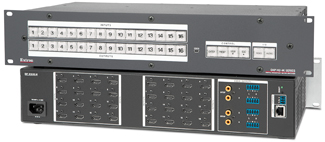The DXP HD 4K series of HDMI matrix switchers from Extron Electronics enables resolutions up to 4K, including 1080p/60 with deep color, with support for HDMI data rates to 10.2 Gbps, deep color up to 12-bit, 3D, and HD lossless audio formats.

- The HDCP-compliant matrix switchers also feature built-in de-embedding, enabling digital audio from any input to be assigned to the digital or analog stereo outputs for streamlined integration. Available in I/O sizes from 4x4 to 16x16, the DXP HD 4K series is ideal for use in applications that require reliable, high-performance routing of digital video and digital or analog audio signals in professional AV environments.
"Many designers are expected to deliver a sophisticated fixed I/O solution for 4K video systems that provides high reliability while also being easy for the end user to operate," said Casey Hall, vice president of sales and marketing at Extron. "Loaded with proven technologies from Extron, the DXP HD 4K matrix switchers provide rock-solid, install-and-forget reliability for routing 4K video and independent audio within the meeting room, lecture hall, or control center."
Extron technologies such as SpeedSwitch, Key Minder, and EDID Minder, along with automatic input cable equalization and output reclocking, enable fast switching speeds, simplified integration, and compatibility between devices, according to the company.
EDID Minder automatically manages EDID by maintaining continuous EDID communication with each source, ensuring that sources power up properly and reliably output content for display.
For HDMI signals with protected content, Key Minder authenticates and maintains continuous HDCP encryption to support reliable switching while enabling simultaneous distribution of a single source signal to one or more displays, and SpeedSwitch Technology provides ultra-fast switching of encrypted signals.
The DXP HD 4K series also switches embedded digital audio from HDMI source signals, along with the corresponding video, to any or all of the selected outputs. To further streamline integration, de-embedded audio can be routed to digital or analog stereo audio outputs to support a separate sound system.
